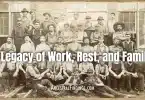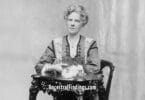James Maitland Stewart, or, as he is usually known, Jimmy Stewart, is an American acting legend, probably best known for being the lead in the classic Christmas film, It’s a Wonderful Life. He was born on May 20, 1908, in Indiana, Pennsylvania, as the eldest child and only son of Alexander Maitland Stewart and Elizabeth Ruth Jackson. He had two younger sisters named Mary and Virginia.
He was of Scottish ancestry, came from a devout Presbyterian family (and was a churchgoer for most of his life), and his family had lived in Pennsylvania for several generations. Jimmy’s father owned and operated a hardware store, which had been in the family for a while, long enough for it to become a family tradition for sons to take over the business when they came of age. Jimmy’s father hoped he would do the same.
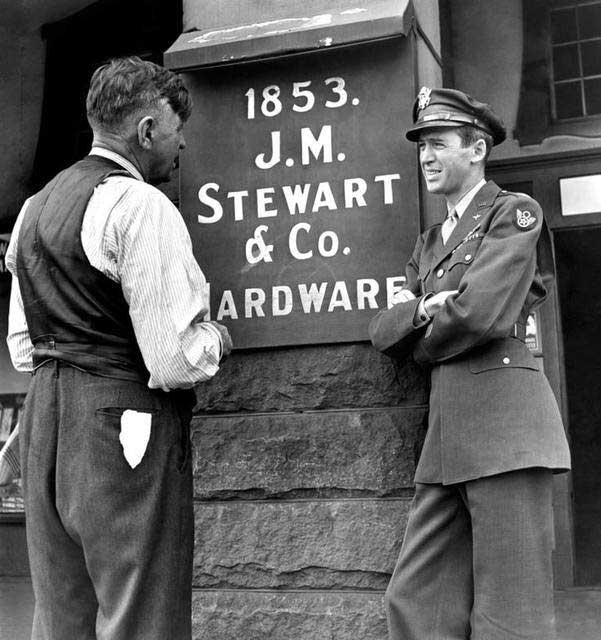
1853 J.M. Stewart & Co. Hardware
Jimmy went into acting after attending Princeton University, much to his father’s chagrin. Initially, Jimmy had been interested in going into aviation and spent much time as a child building model airplanes in his basement. He also showed an interest at school in making mechanical drawings and in the field of chemistry. Yet, his grades were not great. His teachers attributed this not to lack of intelligence, but to lack of focus, due to being creative and spending much class time in daydreaming. Because of his creativity, which needed an outlet, it seemed appropriate that Jimmy was later drawn to acting.
After achieving moderate success as an actor in America, the world changed, and WWII became something the United States realized it was going to have to join, despite its initial reluctance. This is where a little-known, but highly personally influential part of Jimmy Stewart’s life came into play—he became the first big American movie star to enlist in the US military (the Army, in his case) to do his part in the war. It wasn’t so much of a leap for him to make this move. Both of his grandfathers were US Civil War veterans, and his father was a veteran of both the Spanish-American War and WWI. Being in the military was simply part of his family’s traditions.
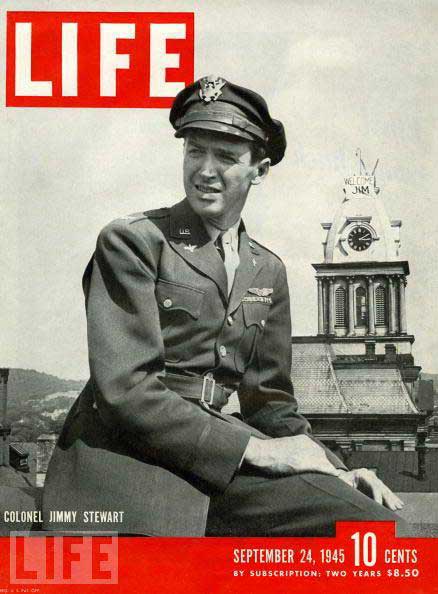
Colonel Jimmy Stewart
Upon first enlisting, Jimmy was rejected from the military for being underweight. This was in November of 1940. He gained some weight and successfully enlisted in February of 1941. Because Jimmy had some experience as an amateur pilot, he asked to be inducted as a private in the still new Air Corps. Yet, at almost 33 years old, Jimmy was considered too old to be a candidate for Aviation Cadet training. This training was the usual path to becoming commissioned as a pilot, navigator, or a bombardier in the Air Corps. To get past this barrier, Jimmy applied to receive an Air Corps commission both as a college graduate and as a licensed commercial pilot. This path worked for him, and Jimmy received a commission as a second lieutenant in January of 1942.
Even though he was enlisted in the military and in training to be a soldier, Jimmy was still under contract with MGM Studios. Because of this, he was allowed to make public appearances during his military service, but they were limited to Army Air Forces engagements. The Air Corps also gave him a one-time radio show with Edgar Bergen and Charlie McCarthy. This was a network show, so people outside of the military were able to listen to it, thus keeping Jimmy in the public’s attention. The radio show was called We Hold These Truths, and was a celebration of the Bill of Rights in the US Constitution. It was broadcast a week after the events of Pearl Harbor.
In addition to the radio show, Jimmy appeared in a short film for the military called Winning Your Wings, which was made to help recruit more men into the Air Corps. The film was nominated for an Academy Award for Best Documentary in 1942, the same year it was released in movie theaters nationwide in the United States. The film is credited with winning 150,000 new recruits for the Air Corps (which was at that time a branch of the Army, and not a separate military branch as it is today).
Jimmy was eager to be in the action of the war, where the exciting and often violent things were happening. Yet, he was concerned that because he was already a celebrity, that status would mean the military would keep him behind the lines so as not to risk the safety of a well-known person. At first, this was true, and Jimmy was not stationed anywhere near where the front-lines war action was happening. After he completed a year-long assignment of training pilots in Albuquerque, New Mexico, Jimmy went to his commander and asked for more challenging assignments on the front lines. Thus, he was sent to England in November of 1943 as part of the 445th Bombardment Group to be a pilot for the B-24 Liberator.
Jimmy was promoted to the rank of Major after a mission to Ludwigshafen, Germany in January of 1944. He received the Distinguished Flying Cross award for his actions as a deputy commander of the 2nda Bombardment Wing. He also received the French Croix de Guerre award (with palm) and the Air Medal (with three oak leaf clusters) awards for his military service. In March of 1945, Jimmy was promoted to Colonel, which made him one of only a small handful of Americans to be promoted from private to Colonel in just a four year period. In this new capacity as a colonel, Jimmy was the presiding officer at a court-martial hearing of a pilot and a navigator who accidentally bombed the city of Zurich, Switzerland.
After the war, Jimmy came back to the United States in the fall of 1945. He was one of twelve founders of the Air Force Association in October of 1945. While he went back to work as an actor soon after coming home from the war, with It’s a Wonderful Life being the first film he appeared in after the war was done, Jimmy was still an active duty military officer. In fact, in July of 1959, Jimmy was promoted to Brigadier General. This made him the highest ranking actor in the history of the US military. Jimmy even did another stint of active military service in February of 1966, when he flew as a non-duty observer in a B-52 plane on a bombing mission during the Vietnam War.
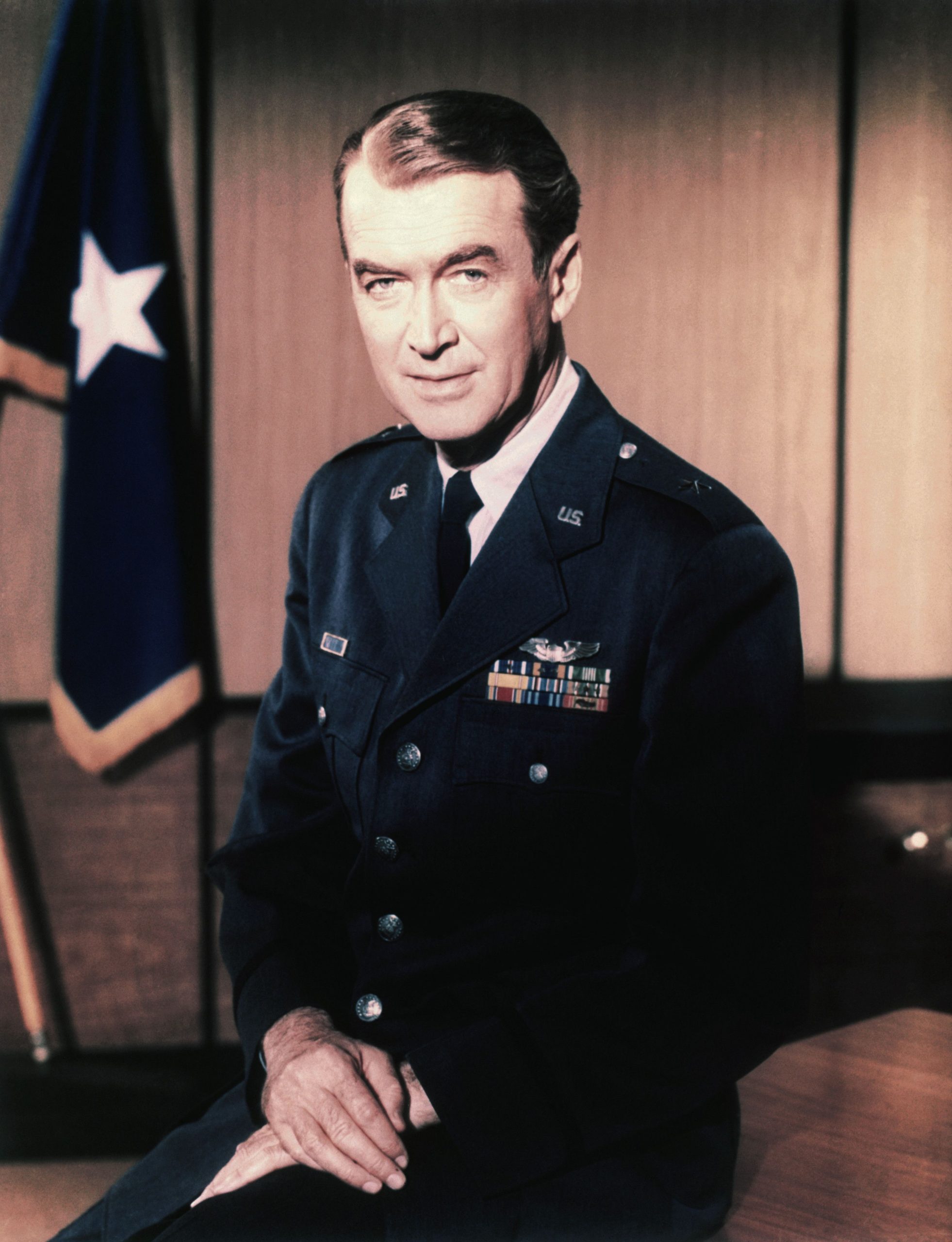
Brigadier General James Stewart
Jimmy spent a total of twenty-seven years in official military service, making movies and being known as a beloved American actor for most of this time. He officially retired from the Air Force (which the Air Corps had become) in May of 1968, when he reached the military’s mandatory retirement age of sixty. When he retired, he was awarded the United States Air Force Distinguished Service medal. Though he usually did not speak to the public about his military career, it was something Jimmy was quite proud of, and rightfully so. He did appear on an episode of a British TV documentary in 1974 called The World at War, where he talked about a particularly disastrous 1943 mission against the city of Schweinfurt, Germany. When Jimmy passed away in 1997, he was buried with full military honors, as befitted a man of his rank, position, and service.


